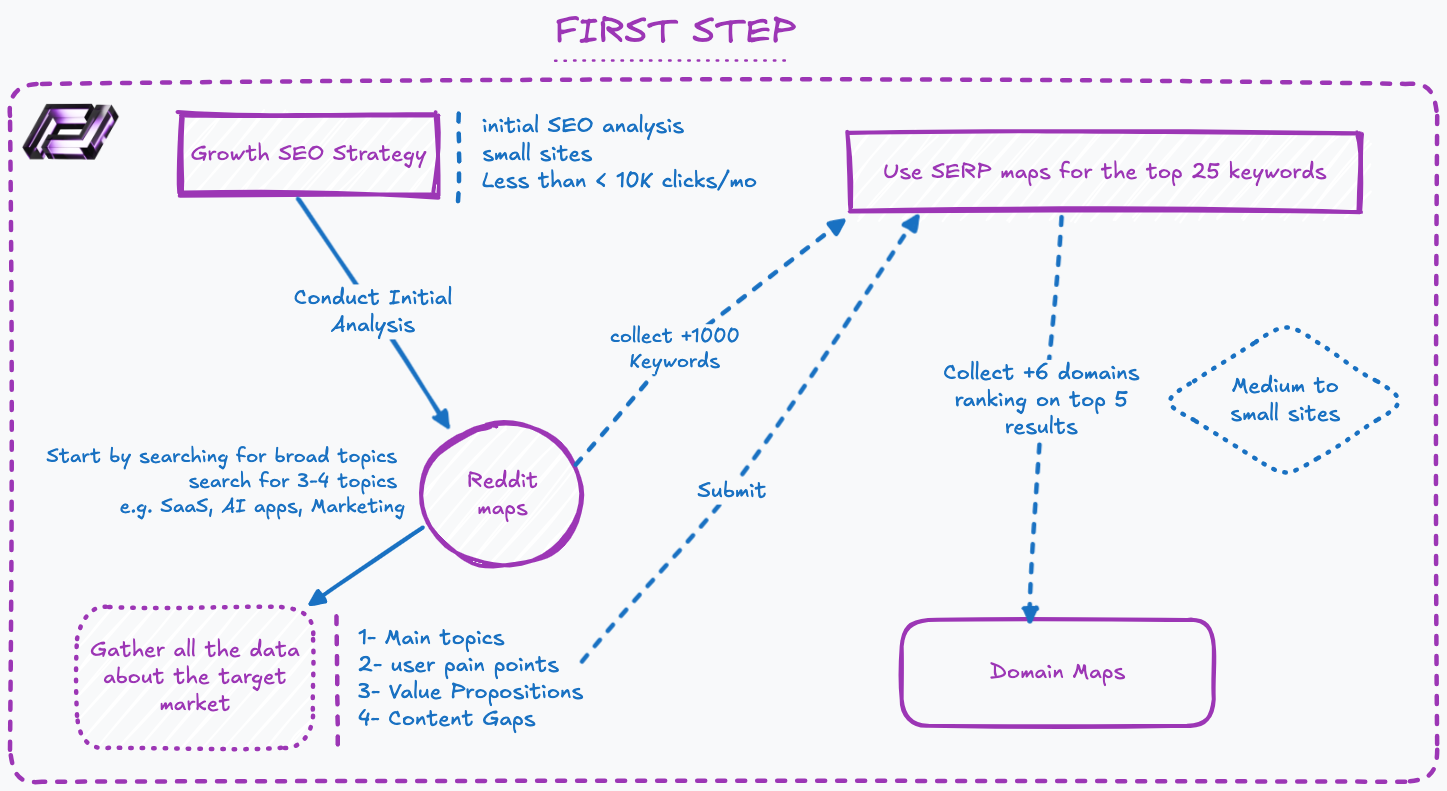Docs
Growth SEO Strategy With Contentmaps AI
This guide outlines a comprehensive, data-driven SEO strategy leveraging the power of Contentmaps AI. We'll move through four key steps: initial analysis, domain mapping, data organization, and finally, building your 6-month plan.
First Step: Initial Analysis and Data Gathering

This stage focuses on laying the groundwork for your content strategy by understanding your target market and the competitive landscape.
Conduct Initial Analysis
Start broad. Brainstorm 3-4 core topics relevant to your business. For a SaaS company, this might be "SaaS," "AI apps," or "Marketing." This helps define the overall subject areas you'll be exploring.
Deep Dive into Reddit
Use the "Reddit Maps" feature of the tool to explore conversations around these broad topics. This will give you a raw, unfiltered view of what real people are saying, their pain points, and the language they use.
This step is crucial for understanding audience sentiment and identifying potential content gaps.
Focus on identifying the main topics discussed, common user pain points, value propositions being offered, and any noticeable content gaps you could fill. Gather all this data about your target market from Reddit.
Tip: Learn more about effectively Using Reddit Maps for in-depth audience analysis and identifying content opportunities by reading our dedicated Reddit Maps Guide.
Keyword Research
Simultaneously, use the insights from Reddit to collect a substantial list of relevant keywords (aim for 1000+). This expands your initial broad topics into a more granular set of specific search terms.
SERP Analysis
Now, shift your focus to the competitive landscape. Use the tool's "SERP Maps" feature to analyze the top 25 keywords you've identified.
This will reveal which domains are consistently ranking for these terms, what type of content they're creating (blog posts, landing pages, videos, etc.), and how they're structuring their content topically.
Specifically, identify and collect around 6 domains that are consistently ranking in the top 5 results for your target keywords. These are likely medium to small-sized sites similar to yours.
Tip: Learn more about effectively Using SERP Maps for in-depth competitor analysis and identifying content opportunities by reading our dedicated SERP Maps Guide.
Second Step: Domain Mapping and Strategy Development
This stage leverages the gathered data to build a targeted content strategy.
Create Domain Maps
Finally, use the tool to create "Domain Maps" for the 6 competitor websites you identified.
This will visually represent their content structure, highlighting their core topics, content clusters, and internal linking strategies. By analyzing these maps, you can identify:
- Content Gaps: Areas where your competitors are lacking content that you could potentially capitalize on.
- Content Overlap: Topics that are heavily covered by competitors, indicating high competition.
- Unique Opportunities: Niche topics or angles that your competitors haven't addressed.
Tip: For a deeper dive into Domain Maps and their strategic application, check out our Domain Maps Guide. It covers advanced techniques for competitor analysis and identifying untapped content opportunities.
Submit & Refine
Submit your findings back into the tool (this step might involve specific functionality within the application, such as saving your SERP Maps and Domain Maps).
This allows the tool to further analyze the data and potentially provide additional insights or recommendations.
Third Step: Data Organization and Knowledge Extraction

This stage is about organizing the raw data from the previous steps into actionable insights.
You'll be using spreadsheets for some data and leveraging the insights already compiled within the topical map tool.
Consolidate Data from Domain & SERP Maps
Spreadsheet Data:
Export or compile the following into a spreadsheet for easy access and analysis:
- Clustered Keywords: Group keywords from both Domain and SERP Maps into topical clusters. This reveals which keyword groups contribute to broader topics.
- Search Volume Data: Include search volume data for each keyword to prioritize high-impact opportunities.
- Website Database: If available, incorporate data about your existing content (URLs, content type, etc.) to identify gaps and overlaps.
- Topical Map Database: This might be an export function from the tool, providing structured data representation of your Domain and SERP Maps.
Insights from Reddit Maps
Refer back to the insights gathered in the initial Reddit analysis. This qualitative data is critical for understanding audience language, pain points, and emerging trends. Use the "Reddit Maps" section of the tool to refine and document the following:
- Audience Engagement Patterns: How frequently are certain topics discussed? Which posts generate the most engagement?
- Value Propositions: What solutions are users seeking? How can your product/service address those needs?
- User Pain Points: What problems are users facing? This helps inform content that addresses specific concerns.
- Content Gaps: Are there unanswered questions or underserved topics within the Reddit discussions?
- Clustered Keywords: Similar to the spreadsheet, group relevant keywords together based on the Reddit conversations.
- Discussion Trends: Are there emerging or recurring themes in the discussions?
Integrate SERP Map Data
Deepen your competitive analysis within the tool by extracting the following from your SERP Maps:
- Topical Maps Database: Download this database from your saved project in the app to review which topics are ranking highest in SERPs.
- Clustered Keywords: Categorize keywords found in the SERP data into relevant topic clusters.
- Schema Maps Data: Analyze any structured data markup (schema) used by competitors to identify opportunities to enhance your site's schema for better search visibility.
Generate AI Insights (within the Tool):
Leverage the AI capabilities of the tool to generate more sophisticated insights based on your collected data. This could include:
- Topical Maps + Database: Create comprehensive topical maps with linked databases that provide a structured view of your target topics and their related keywords.
- Market Opportunities + Content Formats: Identify promising market opportunities and suggest suitable content formats (blog posts, videos, infographics, etc.) to capitalize on them.
- Entity Intelligence + Keyword Opportunities: Uncover relevant entities (people, organizations, locations) and identify related keyword opportunities you might have overlooked. This can provide a deeper understanding of topical relevance and context.
Final Step: Building the 6-Month SEO Plan
Now, combine all your knowledge and insights to create your plan. Use a document platform like Google Docs or Notion, incorporating data from your spreadsheet and the topical map tool:
Domain Maps:
- AI SEO Strategy: Develop an overall SEO strategy driven by the AI-powered insights.
- AI Intent Analysis: Analyze search intent behind target keywords to create content that meets user needs.
- Competitor Topical Map: Create a visual map of your competitors' content to identify gaps and opportunities.
SERP Maps:
- AI Content Briefs: Use AI to generate content briefs outlining key topics, keywords, and target audience for each piece of content.
- Search Intent Analysis: Analyze search intent behind keywords to inform content strategy.
- SERP FAQ: Identify frequently asked questions related to your target keywords for inclusion in your content.
- Search Topical Maps: Construct topical maps to visualize relationships between keywords and topics for better content structuring.
This detailed approach will allow you to develop a data-driven, actionable 6-month SEO plan using the combined power of manual analysis, data organization, and AI-powered insights from a topical mapping tool.
Remember to review and adjust your plan monthly based on performance and new data.
